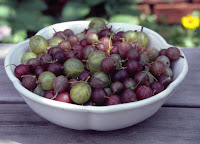
I wasn’t indiscriminate in trespassing this Rule of Gardening. The plants that I pruned were gooseberry bushes, very hardy plants that are unlikely to suffer any cold damage as a result of untimely pruning. Also, no need to wait, as is done with peaches, for growth to begin to see which branches have died back from winter cold; none ever do so on a gooseberry bush.
Enjoying the balmy weather without spring breathing down my back made for a very relaxed pruning session. I had plenty of time to pay attention to details and prune a little differently than in the past.
Gooseberries yield their fruits on stems that are 1-, 2-, and 3-years-old so the usual method of pruning is to cut away any stems more than 3-years-old and remove all but the six of the sturdiest 1-year-old stems. The pruned bush, then, is left with a half-dozen each of 1-, 2-, and 3-year old stems. Each year a bush is renewed as oldest stems are removed, and new grow kept vigorous and healthy as excess young stems are thinned out.
The gooseberry bushes always bear many more berries than we can eat, and their weight bows the branches to the ground. So this year I decided, after doing the usual pruning, as described above, to also prune each side branch on the older stems back to a couple of inches long. I’ll reap fewer berries, but those that remain should be larger and easier to harvest among the thorny stems.
----------------------------------------
Some of you readers might snub all this detail about – of all things – gooseberries. After all, who eats gooseberries these days? Who wants to eat gooseberries these days? To most people, a gooseberry is a small, green, tart berry suitable only for pies, jams, and fools (a dessert made by folding cooked, sweetened, sieved gooseberries into whipped cream).

If small, green, and tart is your idea of a gooseberry, you’ve never tasted a so-called dessert gooseberry. Dessert gooseberries are sweet and flavorful right off the bush; they are, as Edward Bunyard wrote almost a hundred years ago in The Anatomy of Dessert, “the fruit par excellence for ambulant consumption.” (He was from England, where gooseberries are more appreciated and known than here.)
Only certain gooseberry varieties warrant the label “dessert gooseberry,’ of which I grow about a dozen varieties. My favorites include Whitesmith, Hinonmakis Yellow, Poorman, Black Satin, Webster, Red jacket, and Captivator. Their sweet flavors carry wine-y overtones and reminiscences of plum or apricot. Some have soft skins, others firm skins that explode with the flavorful, sweet juice when you bite into them.
-------------------------------------------
Not-so-balmy weather has turned me back indoors. But I’m now on a gardening roll, spurred on further by a box of seed packets that arrived in the mail.

Lettuce, mache, and celery from the greenhouse have been filling our salad bowls all winter. As these plants wane or go to seed, we’ll need more. So today I sowed seeds of Black-Seeded Simpson, Romaine, Buttercrunch, Blushed Butter Cos, and Majestic Red lettuces. Some I sprinkled into seed flats that can be kept warm for quick germination. Some I sowed right in the ground beds in the greenhouse; they’ll germinate more slowly but hold their quality longer than those that are pricked out from seed flats into “cells” and then into the garden.
The next warm day, I’ll grab my pruning shears and get back to the gooseberries.
I have a huge old gooseberry that has become at least 3 gooseberry plants,I haven't seen a gooseberry in years. Should I prune it slowly by thirds each year or just hack away , or better yet start new plants from it, thanks
ReplyDeleteGooseberries do better with some pruning but your gooseberry problem is probably not due to lack of pruning. My guess is that some animal, perhaps an insect, has been eating your berries.
ReplyDelete